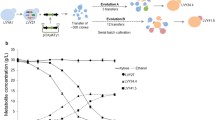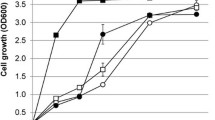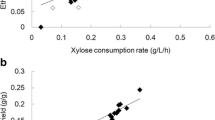Abstract
Lignocellulosic biomass is a renewable raw material for producing several high-value-added chemicals and fuels. In general, xylose and glucose are the major sugars in biomass hydrolysates, and their efficient utilization by microorganisms is critical for an economical production process. Yeasts capable of co-consuming mixed sugars might lead to higher yields and productivities in industrial fermentation processes. Herein, we performed adaptive evolution assays with two xylose-fermenting yeasts, Spathaspora passalidarum and Scheffersomyces stipitis, to obtain derived clones with improved capabilities of glucose and xylose co-consumption. Adapted strains were obtained after successive growth selection using xylose and the non-metabolized glucose analog 2-deoxy-D-glucose as a selective pressure. The co-fermentation capacity of evolved and parental strains was evaluated on xylose-glucose mixtures. Our results revealed an improved co-assimilation capability by the evolved strains; however, xylose and glucose consumption were observed at slower rates than the parental yeasts. Genome resequencing of the evolved strains revealed genes affected by non-synonymous variants that might be involved with the co-consumption phenotype, including the HXT2.4 gene that encodes a putative glucose transporter in Sp. passalidarum. Expression of this mutant HXT2.4 in Saccharomyces cerevisiae improved the cells’ co-assimilation of glucose and xylose. Therefore, our results demonstrated the successful improvement of co-fermentation through evolutionary engineering and the identification of potential targets for further genetic engineering of different yeast strains.
Key points
• Laboratory evolution assay was used to obtain improved sugar co-consumption of non-Saccharomyces strains.
• Evolved Sp. passalidarum and Sc. stipitis were able to more efficiently co-ferment glucose and xylose.
• A mutant Hxt2.4 permease, which co-transports xylose and glucose, was identified.







Similar content being viewed by others
Data availability
Supporting data are available in additional files and the genome projects generated during the current study have been deposited in the Sequence Read Archive (SRA) at the National Center for Biotechnology Information (NCBI) under the BioProject PRJNA783352, with accession numbers SRR17034824, SRR17034825, and SRR17034826.
References
Alkim C, Trichez D, Cam Y, Spina L, François JM, Walther T (2016) The synthetic xylulose-1 phosphate pathway increases production of glycolic acid from xylose-rich sugar mixtures. Biotechnol Biofuels 9:201. https://doi.org/10.1186/s13068-016-0610-2
Almeida JRM, Runquist D, Sànchez Nogué V, Lidén G, Gorwa-Grauslund MF (2011) Stress-related challenges in pentose fermentation to ethanol by the yeast Saccharomyces cerevisiae. Biotechnol J 6:286–299. https://doi.org/10.1002/biot.201000301
Auwera GA, Carneiro MO, Hartl C, Poplin R, del Angel G, Levy-Moonshine A, Jordan T, Shakir K, Roazen D, Thibault J, Banks E, Garimella KV, Altshuler D, Gabriel S, DePristo MA (2013) From FastQ data to high-confidence variant calls: the genome analysis toolkit best practices pipeline. Curr Protoc Bioinforma 43:483–492. https://doi.org/10.1002/0471250953.bi1110s43
Braga M, Ferreira PM, Almeida JRM (2021) Screening method to prioritize relevant bio-based acids and their biochemical processes using recent patent information. Biofuels Bioprod Biorefining 15:231–249. https://doi.org/10.1002/bbb.2156
Cadete RM, de las Heras AM, Sandström AG, Ferreira C, Gírio F, Gorwa-Grauslund M-F, Rosa CA, Fonseca C (2016) Exploring xylose metabolism in Spathaspora species: XYL1.2 from Spathaspora passalidarum as the key for efficient anaerobic xylose fermentation in metabolic engineered Saccharomyces cerevisiae. Biotechnol Biofuels 9:167. https://doi.org/10.1186/s13068-016-0570-6
Cadete RM, Rosa CA (2018) The yeasts of the genus Spathaspora : potential candidates for second-generation biofuel production: Spathaspora yeasts as candidates for 2G bioethanol production. Yeast 35:191–199. https://doi.org/10.1002/yea.3279
Chen K, Wallis JW, McLellan MD, Larson DE, Kalicki JM, Pohl CS, McGrath SD, Wendl MC, Zhang Q, Locke DP, Shi X, Fulton RS, Ley TJ, Wilson RK, Ding L, Mardis ER (2009) BreakDancer: an algorithm for high-resolution mapping of genomic structural variation. Nat Methods 6:677–681. https://doi.org/10.1038/nmeth.1363
Cingolani P, Platts A, Wang LL, Coon M, Nguyen T, Wang L, Land SJ, Lu X, Ruden DM (2012) A program for annotating and predicting the effects of single nucleotide polymorphisms, SnpEff: SNPs in the genome of Drosophila melanogaster strain w 1118; iso-2; iso-3. Fly (austin) 6:80–92. https://doi.org/10.4161/fly.19695
De Jong, Ed, Stichnothe, Heinz, Bell, Geoff Bio-based chemicals: a 2020 update. IEA Bioenergy Online 2020
de Sales BB, Scheid B, Gonçalves DL, Knychala MM, Matsushika A, Bon EPS, Stambuk BU (2015) Cloning novel sugar transporters from Scheffersomyces (Pichia) stipitis allowing d-xylose fermentation by recombinant Saccharomyces cerevisiae. Biotechnol Lett 37:1973–1982. https://doi.org/10.1007/s10529-015-1893-2
dos Santos LV, Carazzolle MF, Nagamatsu ST, Sampaio NMV, Almeida LD, Pirolla RAS, Borelli G, Corrêa TLR, Argueso JL, Pereira GAG (2016) Unraveling the genetic basis of xylose consumption in engineered Saccharomyces cerevisiae strains. Sci Rep 6:38676. https://doi.org/10.1038/srep38676
Farwick A, Bruder S, Schadeweg V, Oreb M, Boles E (2014) Engineering of yeast hexose transporters to transport D-xylose without inhibition by D-glucose. Proc Natl Acad Sci 111:5159–5164. https://doi.org/10.1073/pnas.1323464111
Gancedo JM (2008) The early steps of glucose signalling in yeast. FEMS Microbiol Rev 32:673–704. https://doi.org/10.1111/j.1574-6976.2008.00117.x
Gao M, Ploessl D, Shao Z (2019) Enhancing the co-utilization of biomass-derived mixed sugars by yeasts. Front Microbiol 9:3264. https://doi.org/10.3389/fmicb.2018.03264
Garcia Sanchez R, Karhumaa K, Fonseca C, Sànchez Nogué V, Almeida JR, Larsson CU, Bengtsson O, Bettiga M, Hahn-Hägerdal B, Gorwa-Grauslund MF (2010) Improved xylose and arabinose utilization by an industrial recombinant Saccharomyces cerevisiae strain using evolutionary engineering. Biotechnol Biofuels 3:13. https://doi.org/10.1186/1754-6834-3-13
Gietz RD, Schiestl RH (2007) High-efficiency yeast transformation using the LiAc/SS carrier DNA/PEG method. Nat Protoc 2:31–34. https://doi.org/10.1038/nprot.2007.13
Green MR, Sambrook J, Sambrook J (2012) Molecular cloning: a laboratory manual, 4th edn. Cold Spring Harbor Laboratory Press, Cold Spring Harbor, N.Y.
Ha S-J, Kim H, Lin Y, Jang M-U, Galazka JM, Kim T-J, Cate JHD, Jin Y-S (2013) Single amino acid substitutions in HXT2.4 from Scheffersomyces stipitis lead to improved cellobiose fermentation by engineered Saccharomyces cerevisiae. Appl Environ Microbiol 79:1500–1507. https://doi.org/10.1128/AEM.03253-12
Jeffries TW, Van Vleet JRH (2009) Pichia stipitis genomics, transcriptomics, and gene clusters. FEMS Yeast Res 9:793–807. https://doi.org/10.1111/j.1567-1364.2009.00525.x
Jeffries TW, Grigoriev IV, Grimwood J, Laplaza JM, Aerts A, Salamov A, Schmutz J, Lindquist E, Dehal P, Shapiro H, Jin Y-S, Passoth V, Richardson PM (2007) Genome sequence of the lignocellulose-bioconverting and xylose-fermenting yeast Pichia stipitis. Nat Biotechnol 25:319–326. https://doi.org/10.1038/nbt1290
Kaba HE, Nimtz M, Müller PP, Bilitewski U (2013) Involvement of the mitogen activated protein kinase Hog1p in the response of Candida albicans to iron availability. BMC Microbiol 13:16. https://doi.org/10.1186/1471-2180-13-16
Karhumaa K, Wiedemann B, Hahn-Hägerdal B, Boles E, Gorwa-Grauslund M-F (2006) Co-utilization of L-arabinose and D-xylose by laboratory and industrial Saccharomyces cerevisiae strains. Microb Cell Factories 5:18. https://doi.org/10.1186/1475-2859-5-18
Katoh K, Standley DM (2013) MAFFT multiple sequence alignment software version 7: improvements in performance and usability. Mol Biol Evol 30:772–780. https://doi.org/10.1093/molbev/mst010
Kayikci Ö, Nielsen J (2015) Glucose repression in Saccharomyces cerevisiae. FEMS Yeast Res 15:fov068. https://doi.org/10.1093/femsyr/fov068
Kim J-H, Block DE, Mills DA (2010) Simultaneous consumption of pentose and hexose sugars: an optimal microbial phenotype for efficient fermentation of lignocellulosic biomass. Appl Microbiol Biotechnol 88:1077–1085. https://doi.org/10.1007/s00253-010-2839-1
Kim SR, Ha SJ, Wei N, Oh EJ, Jin YS (2012) Simultaneous co-fermentation of mixed sugars: a promising strategy for producing cellulosic ethanol. Trends Biotechnol 30(5):274–282. https://doi.org/10.1016/j.tibtech.2012.01.005
Lane S, Xu H, Oh EJ, Kim H, Lesmana A, Jeong D, Zhang G, Tsai C-S, Jin Y-S, Kim SR (2018) Glucose repression can be alleviated by reducing glucose phosphorylation rate in Saccharomyces cerevisiae. Sci Rep 8:2613. https://doi.org/10.1038/s41598-018-20804-4
Laussel C, Léon S (2020) Cellular toxicity of the metabolic inhibitor 2-deoxyglucose and associated resistance mechanisms. Biochem Pharmacol 182:114213. https://doi.org/10.1016/j.bcp.2020.114213
Li H (2011) A statistical framework for SNP calling, mutation discovery, association mapping and population genetical parameter estimation from sequencing data. Bioinformatics 27:2987–2993. https://doi.org/10.1093/bioinformatics/btr509
Li H, Durbin R (2009) Fast and accurate short read alignment with Burrows-Wheeler transform. Bioinformatics 25:1754–1760. https://doi.org/10.1093/bioinformatics/btp324
Lin Y, Cai Y, Guo Y, Li X, Qi X, Qi Q, Wang Q (2019) Development and genomic elucidation of hybrid yeast with improved glucose-xylose co-fermentation at high temperature. FEMS Yeast Res 19:foz015. https://doi.org/10.1093/femsyr/foz015
Long TM, Su Y-K, Headman J, Higbee A, Willis LB, Jeffries TW (2012) Cofermentation of glucose, xylose, and cellobiose by the beetle-associated yeast Spathaspora passalidarum. Appl Environ Microbiol 78:5492–5500. https://doi.org/10.1128/AEM.00374-12
Ma K, He M, You H, Pan L, Hu G, Cui Y, Maeda T (2017) Enhanced fuel ethanol production from rice straw hydrolysate by an inhibitor-tolerant mutant strain of Scheffersomyces stipitis. RSC Adv 7:31180–31188. https://doi.org/10.1039/C7RA04049K
Maeda T, Takekawa M, Saito H (1995) Activation of yeast PBS2 MAPKK by MAPKKKs or by binding of an SH3-containing osmosensor. Science 269:554–558. https://doi.org/10.1126/science.7624781
Martinez R, Flores AD, Dufault ME, Wang X (2019) The XylR variant (R121C and P363S) releases arabinose-induced catabolite repression on xylose fermentation and enhances coutilization of lignocellulosic sugar mixtures. Biotechnol Bioeng 116:3476–3481. https://doi.org/10.1002/bit.27144
McCartney RR, Chandrashekarappa DG, Zhang BB, Schmidt MC (2014) Genetic analysis of resistance and sensitivity to 2-deoxyglucose in Saccharomyces cerevisiae. Genetics 198:635–646. https://doi.org/10.1534/genetics.114.169060
McKenna A, Hanna M, Banks E, Sivachenko A, Cibulskis K, Kernytsky A, Garimella K, Altshuler D, Gabriel S, Daly M, DePristo MA (2010) The Genome Analysis Toolkit: a MapReduce framework for analyzing next-generation DNA sequencing data. Genome Res 20:1297–1303. https://doi.org/10.1101/gr.107524.110
Moriya H, Johnston M (2004) Glucose sensing and signaling in Saccharomyces cerevisiae through the Rgt2 glucose sensor and casein kinase I. Proc Natl Acad Sci 101:1572–1577. https://doi.org/10.1073/pnas.0305901101
Moysés D, Reis V, Almeida J, Moraes L, Torres F (2016) Xylose fermentation by Saccharomyces cerevisiae: challenges and prospects. Int J Mol Sci 17:207. https://doi.org/10.3390/ijms17030207
Mumberg D, Müller R, Funk M (1995) Yeast vectors for the controlled expression of heterologous proteins in different genetic backgrounds. Gene 156:119–122. https://doi.org/10.1016/0378-1119(95)00037-7
Nakanishi SC, Soares LB, Biazi LE, Nascimento VM, Costa AC, Rocha GJM, Ienczak JL (2017) Fermentation strategy for second generation ethanol production from sugarcane bagasse hydrolyzate by Spathaspora passalidarum and Scheffersomyces stipitis: Fermentation Strategy for Second Generation Ethanol Production. Biotechnol Bioeng 114:2211–2221. https://doi.org/10.1002/bit.26357
Nguyen NH, Suh S-O, Marshall CJ, Blackwell M (2006) Morphological and ecological similarities: wood-boring beetles associated with novel xylose-fermenting yeasts, Spathaspora passalidarum gen. sp. nov. and Candida jeffriesii sp. nov. Mycol Res 110:1232–1241. https://doi.org/10.1016/j.mycres.2006.07.002
Nijland JG, Driessen AJM (2020) Engineering of pentose transport in Saccharomyces cerevisiae for biotechnological applications. Front Bioeng Biotechnol 7:464. https://doi.org/10.3389/fbioe.2019.00464
Pacheco TF, Machado BRC, de Morais Júnior WG, Almeida JRM, Gonçalves SB (2021) Enhanced tolerance of Spathaspora passalidarum to sugarcane bagasse hydrolysate for ethanol production from xylose. Appl Biochem Biotechnol 193:2182–2197. https://doi.org/10.1007/s12010-021-03544-6
Papapetridis I, Verhoeven MD, Wiersma SJ, Goudriaan M, van Maris AJA, Pronk JT (2018) Laboratory evolution for forced glucose-xylose co-consumption enables identification of mutations that improve mixed-sugar fermentation by xylose-fermenting Saccharomyces cerevisiae. FEMS Yeast Res 18. https://doi.org/10.1093/femsyr/foy056
Price MN, Dehal PS, Arkin AP (2009) FastTree: computing large minimum evolution trees with profiles instead of a distance matrix. Mol Biol Evol 26:1641–1650. https://doi.org/10.1093/molbev/msp077
Radecka D, Mukherjee V, Mateo RQ, Stojiljkovic M, Foulquié-Moreno MR, Thevelein JM (2015) Looking beyond Saccharomyces : the potential of non-conventional yeast species for desirable traits in bioethanol fermentation. FEMS Yeast Res 15:fov053. https://doi.org/10.1093/femsyr/fov053
Reider Apel A, Ouellet M, Szmidt-Middleton H, Keasling JD, Mukhopadhyay A (2016) Evolved hexose transporter enhances xylose uptake and glucose/xylose co-utilization in Saccharomyces cerevisiae. Sci Rep 6:19512. https://doi.org/10.1038/srep19512
Ribeiro LE, Albuini FM, Castro AG, Campos VJ, de Souza GB, Mendonça JGP, Rosa CA, Mendes TAO, Santana MF, da Silveira WB, Fietto LG (2021) Influence of glucose on xylose metabolization by Spathaspora passalidarum. Fungal Genet Biol 103624. https://doi.org/10.1016/j.fgb.2021.103624
Rodrussamee N, Sattayawat P, Yamada M (2018) Highly efficient conversion of xylose to ethanol without glucose repression by newly isolated thermotolerant Spathaspora passalidarum CMUWF1–2. BMC Microbiol 18:73. https://doi.org/10.1186/s12866-018-1218-4
Saito H, Posas F (2012) Response to hyperosmotic stress. Genetics 192:289–318. https://doi.org/10.1534/genetics.112.140863
Soares CEVF, Bergmann JC, de Almeida JRM (2021) Variable and dose-dependent response of Saccharomyces and non-Saccharomyces yeasts toward lignocellulosic hydrolysate inhibitors. Braz J Microbiol 52:575–586. https://doi.org/10.1007/s42770-021-00489-0
Sreenath HK, Jeffries TW (1999) 2-Deoxyglucose as a selective agent for derepressed mutants of Pichia stipitis. Appl Biochem Biotechnol 77:211–222. https://doi.org/10.1385/ABAB:77:1-3:211
Su Y, Willis LB, Jeffries TW (2015) Effects of aeration on growth, ethanol and polyol accumulation by Spathaspora passalidarum NRRL Y-27907 and Scheffersomyces stipitis NRRL Y-7124. Biotechnol Bioeng 112:457–469. https://doi.org/10.1002/bit.25445
Su Y-K, Willis LB, Rehmann L, Smith DR, Jeffries TW (2018) Spathaspora passalidarum selected for resistance to AFEX hydrolysate shows decreased cell yield. FEMS Yeast Res 18. https://doi.org/10.1093/femsyr/foy011
Tamayo Rojas SA, Schmidl S, Boles E, Oreb M (2021) Glucose-induced internalization of the S. cerevisiae galactose permease Gal2 is dependent on phosphorylation and ubiquitination of its aminoterminal cytoplasmic tail. FEMS Yeast Res 21:foab019. https://doi.org/10.1093/femsyr/foab019
Veras HCT, Parachin NS, Almeida JRM (2017) Comparative assessment of fermentative capacity of different xylose-consuming yeasts. Microb Cell Factories 16:153. https://doi.org/10.1186/s12934-017-0766-x
Veras HCT, Campos CG, Nascimento IF, Abdelnur PV, Almeida JRM, Parachin NS (2019) Metabolic flux analysis for metabolome data validation of naturally xylose-fermenting yeasts. BMC Biotechnol 19:58. https://doi.org/10.1186/s12896-019-0548-0
Verstrepen KJ, Iserentant D, Malcorps P, Derdelinckx G, Van Dijck P, Winderickx J, Pretorius IS, Thevelein JM, Delvaux FR (2004) Glucose and sucrose: hazardous fast-food for industrial yeast? Trends Biotechnol 22:531–537. https://doi.org/10.1016/j.tibtech.2004.08.001
Wieczorke R, Krampe S, Weierstall T, Freidel K, Hollenberg CP, Boles E (1999) Concurrent knock-out of at least 20 transporter genes is required to block uptake of hexoses in Saccharomyces cerevisiae. FEBS Lett 464:123–128. https://doi.org/10.1016/S0014-5793(99)01698-1
Winston F (2008) EMS and UV mutagenesis in yeast. Curr Protoc Mol Biol 82. https://doi.org/10.1002/0471142727.mb1303bs82
Wohlbach DJ, Kuo A, Sato TK, Potts KM, Salamov AA, LaButti KM, Sun H, Clum A, Pangilinan JL, Lindquist EA, Lucas S, Lapidus A, Jin M, Gunawan C, Balan V, Dale BE, Jeffries TW, Zinkel R, Barry KW, Grigoriev IV, Gasch AP (2011) Comparative genomics of xylose-fermenting fungi for enhanced biofuel production. Proc Natl Acad Sci 108:13212–13217. https://doi.org/10.1073/pnas.1103039108
Young E, Poucher A, Comer A, Bailey A, Alper H (2011) Functional survey for heterologous sugar transport proteins, using Saccharomyces cerevisiae as a host. Appl Environ Microbiol 77:3311–3319. https://doi.org/10.1128/AEM.02651-10
Young EM, Tong A, Bui H, Spofford C, Alper HS (2014) Rewiring yeast sugar transporter preference through modifying a conserved protein motif. Proc Natl Acad Sci 111:131–136. https://doi.org/10.1073/pnas.1311970111
Acknowledgements
This work was developed in partnership with the Centro de Tecnologia Canavieira S/A (Sugarcane Technology Center—CTC).
Funding
This work was supported by funding from The Brazilian Agricultural Research Corporation (EMBRAPA), Brazilian Development Bank (BNDES), and Centro de Tecnologia Canavieira S/A (Sugarcane Technology Center—CTC).
Author information
Authors and Affiliations
Contributions
DT conducted experiments, analyzed data, and wrote the manuscript. WGMJ, NV, and JCB performed experiments. ASS and EFF performed the variant analysis and revised the manuscript. SG supervised the study and revised the manuscript. JRMA designed the study, revised the manuscript, and supervised the project. All authors read and approved the final manuscript.
Corresponding author
Ethics declarations
Ethics approval and consent to participate
Not applicable.
Consent for publication
Not applicable.
Competing interests
The authors declare no competing interests.
Additional information
Publisher's note
Springer Nature remains neutral with regard to jurisdictional claims in published maps and institutional affiliations.
Supplementary Information
Below is the link to the electronic supplementary material.
Rights and permissions
Springer Nature or its licensor (e.g. a society or other partner) holds exclusive rights to this article under a publishing agreement with the author(s) or other rightsholder(s); author self-archiving of the accepted manuscript version of this article is solely governed by the terms of such publishing agreement and applicable law.
About this article
Cite this article
Trichez, D., Steindorff, A.S., de Morais Júnior, W.G. et al. Identification of traits to improve co-assimilation of glucose and xylose by adaptive evolution of Spathaspora passalidarum and Scheffersomyces stipitis yeasts. Appl Microbiol Biotechnol 107, 1143–1157 (2023). https://doi.org/10.1007/s00253-023-12362-1
Received:
Revised:
Accepted:
Published:
Issue Date:
DOI: https://doi.org/10.1007/s00253-023-12362-1




